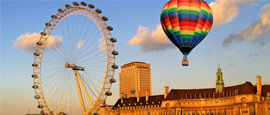London History
Tucked into a curve of the Thames, London began life as Londinium, a small Roman port village connecting the territory of the Trinovantes tribe with that of the Catuvellauni to the north. But importance came at a price and in AD61, the settlement was razed by the armies of Iceni Queen Boudicca.
Next to occupy the site were the Saxons, who took control after the Romans withdrew, and withstood several onslaughts from the Vikings before being ousted by the Normans in 1066. The Saxons left Westminster Abbey behind. The Normans built castles instead, with the Tower of London’s White Tower begun under William the Conqueror. Subsequent years saw the city become England’s dominant metropolis, with Whitehall Palace in the centre of London joining the Tower as England’s seat of power.
But while England’s kings and queens - and occasionally its peasants - continued to bring about changes to the city’s architecture, it wasn’t until the reign of Elizabeth I that it developed a reputation for culture, thanks in no small part to Shakespeare and the famous School of Night.
Although the Gunpowder Plot of 1605 was foiled, the next century would be marked by turmoil, with London enduring civil war, plague, fire and the only execution of an English monarch in history. With the advent of the Georgians came stability and empire, with London growing rich. This continued during the Victorian period, with London remaining prosperous throughout the WWI and the Great Depression that followed.
WWII put an end to the party, with the fearsome Blitz unleashed on the British capital reducing much of the East End to rubble. A sluggish economy in the 1960s and 70s compounded the malaise, as did IRA bomb attacks in the 1970s and 80s. Despite their best efforts, London has bounced back, gathering steam in the 1990s and hosting the Olympic Games in 2012. Today, it is one of the wealthiest and most cosmopolitan cities in the world.
Did you know?
• Marx and Engel’s Communist Manifestowas first published in Liverpool Street in 1848.
• Cock Lane in Holborn got its name because it was the only street licensed for prostitution in mediaeval times.
• More than 1,000 bodies are buried beneath Aldgate Station in a plague pit dating from 1665.
Do you have any Feedback about this page?
© 2025 Columbus Travel Media Ltd. All rights reserved. No part of this site may be reproduced without our written permission, click here for information on Columbus Content Solutions.




 You know where
You know where